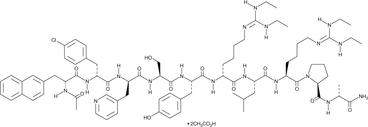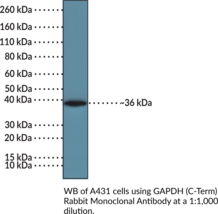Cayman
Showing 21601–21750 of 45550 results
-
Ganglioside GM2 asialo (asialo- GM2; Item No. 24629) is a glycosphingolipid containing three monosaccharide residues and a fatty acid of variable chain length but lacking the sialic acid residue present on ganglioside M2. Asialo-GM2 levels are low-to-undetectable in normal human brain, but it accumulates in the brain of patients with Tay-Sachs and Sandhoff disease, which are neurodegenerative disorders characterized by deficiency of lysosomal β-hexosaminidase A and B, respectively.{40891} It also binds to various bacteria, including Pseudomonas isolates derived from cystic fibrosis patients.{40892} Ganglioside GM2 Asialo Polyclonal Antibody can be used for ELISA and TLC immunoblotting. [Matreya, LLC. Catalog No. 1951]
Brand:CaymanSKU:28639 - 50 µlAvailable on backorder
Immunogen: Purified ganglioside GM2 Asialo and complete Freund’s adjuvant• Host: Rabbit • Applications: ELISA and TLC immunoblotting
Brand:CaymanSKU:28639- 50 µlAvailable on backorder
Immunogen: Purified ganglioside GM2 Asialo and complete Freund’s adjuvant• Host: Rabbit • Applications: ELISA and TLC immunoblotting
Brand:CaymanSKU:28639- 50 µlGanglioside GM2 is a glycosphingolipid component of cellular membranes, primarily the plasma membrane.{43702} Gangliosides isolated from apoptogenic glioblastoma multiforme (GBM) cells are enriched in ganglioside GM2 compared with nonapoptogenic GBM cells, and ganglioside GM2 induces activated T cell death when used at a concentration of 150 μg/ml in vitro.{61125} Serum ganglioside GM2 levels are increased in patients with breast cancer or cholangiocarcinoma.{61126,61127} Levels of ganglioside GM2 are elevated in the brain of patients with Sandhoff disease, as well as feline and mouse models of the disease.{40891} Ganglioside GM2 accumulates in the lysosomes of individuals with Tay-Sachs disease and GM2-activator deficiency, as well as in the CNS of patients with and animal models of mucopolysaccharide storage disorders and Niemann-Pick disease types A, C1, and C2.{40891,43703} Ganglioside GM2 mixture contains ganglioside GM2 molecular species isolated from bovine brain with primarily C18:0 fatty acyl chain lengths. [Matreya, LLC. Catalog No. 1542]
Brand:CaymanSKU:31710 - 1 mgAvailable on backorder
Ganglioside GM2 is a glycosphingolipid component of cellular membranes, primarily the plasma membrane.{43702} Gangliosides isolated from apoptogenic glioblastoma multiforme (GBM) cells are enriched in ganglioside GM2 compared with nonapoptogenic GBM cells, and ganglioside GM2 induces activated T cell death when used at a concentration of 150 μg/ml in vitro.{61125} Serum ganglioside GM2 levels are increased in patients with breast cancer or cholangiocarcinoma.{61126,61127} Levels of ganglioside GM2 are elevated in the brain of patients with Sandhoff disease, as well as feline and mouse models of the disease.{40891} Ganglioside GM2 accumulates in the lysosomes of individuals with Tay-Sachs disease and GM2-activator deficiency, as well as in the CNS of patients with and animal models of mucopolysaccharide storage disorders and Niemann-Pick disease types A, C1, and C2.{40891,43703} Ganglioside GM2 mixture contains ganglioside GM2 molecular species isolated from bovine brain with primarily C18:0 fatty acyl chain lengths. [Matreya, LLC. Catalog No. 1542]
Brand:CaymanSKU:31710 - 500 µgAvailable on backorder
Ganglioside GM2 is a glycosphingolipid component of cellular membranes, primarily the plasma membrane.{43702} Gangliosides isolated from apoptogenic glioblastoma multiforme (GBM) cells are enriched in ganglioside GM2 compared with nonapoptogenic GBM cells, and ganglioside GM2 induces activated T cell death when used at a concentration of 150 μg/ml in vitro.{61125} Serum ganglioside GM2 levels are increased in patients with breast cancer or cholangiocarcinoma.{61126,61127} Levels of ganglioside GM2 are elevated in the brain of patients with Sandhoff disease, as well as feline and mouse models of the disease.{40891} Ganglioside GM2 accumulates in the lysosomes of individuals with Tay-Sachs disease and GM2-activator deficiency, as well as in the CNS of patients with and animal models of mucopolysaccharide storage disorders and Niemann-Pick disease types A, C1, and C2.{40891,43703} Ganglioside GM2 mixture contains ganglioside GM2 molecular species with C18:1 and C20:1 sphingoid backbones.
Brand:CaymanSKU:27192 - 500 µgAvailable on backorder
Ganglioside GM3 is a monosialoganglioside that demonstrates antiproliferative and pro-apoptotic effects in tumor cells by modulating cell adhesion, proliferation, and differentiation.{25490,25485} It suppresses angiogenesis and reduces proliferation and migration of human umbilical vein endothelial cells (HUVECs) when used at a concentration of 20 μM via inhibition of VEGFR2 and Akt phosphorylation.{25490,25485} Ganglioside GM3 induces dissociation of the insulin receptor-caveolin-1 complex from lipid microdomains, functioning as an inhibitor of insulin signaling and contributing to insulin resistance in adipocytes.{25481} Ganglioside GM3 mixture contains ganglioside GM3 molecular species with variable fatty acyl chain lengths. [Matreya, LLC. Catalog No. 1503]
Brand:CaymanSKU:31711 - 1 mgAvailable on backorder
Ganglioside GM3 is a monosialoganglioside that demonstrates antiproliferative and pro-apoptotic effects in tumor cells by modulating cell adhesion, proliferation, and differentiation.{25490,25485} It suppresses angiogenesis and reduces proliferation and migration of human umbilical vein endothelial cells (HUVECs) when used at a concentration of 20 μM via inhibition of VEGFR2 and Akt phosphorylation.{25490,25485} Ganglioside GM3 induces dissociation of the insulin receptor-caveolin-1 complex from lipid microdomains, functioning as an inhibitor of insulin signaling and contributing to insulin resistance in adipocytes.{25481} Ganglioside GM3 mixture contains ganglioside GM3 molecular species with variable fatty acyl chain lengths. [Matreya, LLC. Catalog No. 1503]
Brand:CaymanSKU:31711 - 5 mgAvailable on backorder
Ganglioside GM3 is a monosialoganglioside that demonstrates antiproliferative and pro-apoptotic effects in tumor cells by modulating cell adhesion, proliferation, and differentiation.{25490,25485} It suppresses angiogenesis and reduces proliferation and migration of human umbilical vein endothelial cells (HUVECs) when used at a concentration of 20 μM via inhibition of VEGFR2 and Akt phosphorylation.{25490,25485} Ganglioside GM3 induces dissociation of the insulin receptor-caveolin-1 complex from lipid microdomains, functioning as an inhibitor of insulin signaling and contributing to insulin resistance in adipocytes.{25481} Ganglioside GM3 mixture contains ganglioside GM3 molecular species with C18:1 and C20:1 sphingoid backbones.
Brand:CaymanSKU:-Ganglioside GQ1b is a tetrasialoganglioside that contains two sialic acid residues linked to an inner galactose unit. It stimulates phosphorylation of several ecto-type protein kinase substrates on the surface of GOTO human neuroblastoma cells when used at a concentration of 5 nM.{25486} Ganglioside GQ1b promotes differentiation of murine embryonic stem cells (mESCs) to neuronal precursor and glial cells via activation of the ERK1/2 pathway.{25483} It also induces differentiation of murine keratinocytes through phosphoinositide turnover.{25487} Ganglioside GQ1b mixture contains ganglioside GQ1b molecular species with variable fatty acyl chain lengths. [Matreya, LLC. Catalog No. 1516]
Brand:CaymanSKU:31561 - 1 mgAvailable on backorder
Ganglioside GQ1b is a tetrasialoganglioside that contains two sialic acid residues linked to an inner galactose unit. It stimulates phosphorylation of several ecto-type protein kinase substrates on the surface of GOTO human neuroblastoma cells when used at a concentration of 5 nM.{25486} Ganglioside GQ1b promotes differentiation of murine embryonic stem cells (mESCs) to neuronal precursor and glial cells via activation of the ERK1/2 pathway.{25483} It also induces differentiation of murine keratinocytes through phosphoinositide turnover.{25487} Ganglioside GQ1b mixture contains ganglioside GQ1b molecular species with variable fatty acyl chain lengths. [Matreya, LLC. Catalog No. 1516]
Brand:CaymanSKU:31561 - 100 µgAvailable on backorder
Ganglioside GQ1b is a tetrasialoganglioside that contains two sialic acid residues linked to an inner galactose unit. It stimulates phosphorylation of several ecto-type protein kinase substrates on the surface of GOTO human neuroblastoma cells when used at a concentration of 5 nM.{25486} Ganglioside GQ1b promotes differentiation of murine embryonic stem cells (mESCs) to neuronal precursor and glial cells via activation of the ERK1/2 pathway.{25483} It also induces differentiation of murine keratinocytes through phosphoinositide turnover.{25487} Ganglioside GQ1b mixture contains ganglioside GQ1b molecular species isolated from porcine brain with primarily C18:0 fatty acyl chain lengths, as well as a lower amount of C20:0 fatty acyl chain lengths, among various others. [Matreya, LLC. Catalog No. 1549]
Brand:CaymanSKU:31562 - 1 mgAvailable on backorder
Ganglioside GQ1b is a tetrasialoganglioside that contains two sialic acid residues linked to an inner galactose unit. It stimulates phosphorylation of several ecto-type protein kinase substrates on the surface of GOTO human neuroblastoma cells when used at a concentration of 5 nM.{25486} Ganglioside GQ1b promotes differentiation of murine embryonic stem cells (mESCs) to neuronal precursor and glial cells via activation of the ERK1/2 pathway.{25483} It also induces differentiation of murine keratinocytes through phosphoinositide turnover.{25487} Ganglioside GQ1b mixture contains ganglioside GQ1b molecular species isolated from porcine brain with primarily C18:0 fatty acyl chain lengths, as well as a lower amount of C20:0 fatty acyl chain lengths, among various others. [Matreya, LLC. Catalog No. 1549]
Brand:CaymanSKU:31562 - 100 µgAvailable on backorder
Ganglioside GQ1b is a tetrasialoganglioside that contains two sialic acid residues linked to an inner galactose unit. It stimulates phosphorylation of several ecto-type protein kinase substrates on the surface of GOTO human neuroblastoma cells when used at a concentration of 5 nM.{25486} Ganglioside GQ1b promotes differentiation of murine embryonic stem cells (mESCs) to neuronal precursor and glial cells via activation of the ERK1/2 pathway.{25483} It also induces differentiation of murine keratinocytes through phosphoinositide turnover.{25487} Ganglioside GQ1b mixture contains ganglioside GQ1b molecular species with C18:1 and C20:1 sphingoid backbones.
Brand:CaymanSKU:-Ganglioside GQ1b is a tetrasialoganglioside that contains two sialic acid residues linked to an inner galactose unit. It stimulates phosphorylation of several ecto-type protein kinase substrates on the surface of GOTO human neuroblastoma cells when used at a concentration of 5 nM.{25486} Ganglioside GQ1b promotes differentiation of murine embryonic stem cells (mESCs) to neuronal precursor and glial cells via activation of the ERK1/2 pathway.{25483} It also induces differentiation of murine keratinocytes through phosphoinositide turnover.{25487} Ganglioside GQ1b mixture contains ganglioside GQ1b molecular species with C18:1 and C20:1 sphingoid backbones.
Brand:CaymanSKU:-Ganglioside GT1b is a trisialoganglioside that is characterized by having two sialic residues linked to the inner galactose unit. It binds to the neurotoxins botulinum toxin serotype A (BTxA), BTxA heavy chain, and tetanus toxin with IC50 values of 11, 0.74, and 7.2 μM, respectively.{37775} Ganglioside GT1b-containing liposomes bind to the major coat protein VP1 from Merkel cell polyomavirus (MCPyV), which has been identified in Merkel cell carcinomas, identifying ganglioside GT1b as a putative MCPyV receptor.{25480} Ganglioside GT1b decreases spontaneous production of IL-6, IL-10, IgG, IgM, and IgA in human peripheral blood mononuclear cells (PBMCs) by 31.4, 30.5, 60, 59.5, and 58%, respectively, when used at a concentration of 10 μM.{25482} Ganglioside GT1b Mixture contains bovine ganglioside GT1b molecular species with variable fatty acyl chain lengths. [Matreya, LLC. Catalog No. 1063]
Brand:CaymanSKU:31712 - 1 mgAvailable on backorder
Ganglioside GT1b is a trisialoganglioside that is characterized by having two sialic residues linked to the inner galactose unit. It binds to the neurotoxins botulinum toxin serotype A (BTxA), BTxA heavy chain, and tetanus toxin with IC50 values of 11, 0.74, and 7.2 μM, respectively.{37775} Ganglioside GT1b-containing liposomes bind to the major coat protein VP1 from Merkel cell polyomavirus (MCPyV), which has been identified in Merkel cell carcinomas, identifying ganglioside GT1b as a putative MCPyV receptor.{25480} Ganglioside GT1b decreases spontaneous production of IL-6, IL-10, IgG, IgM, and IgA in human peripheral blood mononuclear cells (PBMCs) by 31.4, 30.5, 60, 59.5, and 58%, respectively, when used at a concentration of 10 μM.{25482} Ganglioside GT1b Mixture contains bovine ganglioside GT1b molecular species with variable fatty acyl chain lengths. [Matreya, LLC. Catalog No. 1063]
Brand:CaymanSKU:31712 - 5 mgAvailable on backorder
Ganglioside GT1b is a trisialoganglioside that is characterized by having two sialic residues linked to the inner galactose unit. It binds to the neurotoxins botulinum toxin serotype A (BTxA), BTxA heavy chain, and tetanus toxin with IC50 values of 11, 0.74, and 7.2 μM, respectively.{37775} Ganglioside GT1b-containing liposomes bind to the major coat protein VP1 from Merkel cell polyomavirus (MCPyV), which has been identified in Merkel cell carcinomas, identifying ganglioside GT1b as a putative MCPyV receptor.{25480} Ganglioside GT1b decreases spontaneous production of IL-6, IL-10, IgG, IgM, and IgA in human peripheral blood mononuclear cells (PBMCs) by 31.4, 30.5, 60, 59.5, and 58%, respectively, when used at a concentration of 10 μM.{25482} Ganglioside GT1b mixture contains porcine ganglioside GT1b molecular species with primarily C18:0 fatty acyl chain lengths, as well as a lower amount of C20:0 fatty acyl chain lengths, among various others.[Matreya, LLC. Catalog Number. 1548]
Brand:CaymanSKU:31592 - 1 mgAvailable on backorder
Ganglioside GT1b is a trisialoganglioside that is characterized by having two sialic residues linked to the inner galactose unit. It binds to the neurotoxins botulinum toxin serotype A (BTxA), BTxA heavy chain, and tetanus toxin with IC50 values of 11, 0.74, and 7.2 μM, respectively.{37775} Ganglioside GT1b-containing liposomes bind to the major coat protein VP1 from Merkel cell polyomavirus (MCPyV), which has been identified in Merkel cell carcinomas, identifying ganglioside GT1b as a putative MCPyV receptor.{25480} Ganglioside GT1b decreases spontaneous production of IL-6, IL-10, IgG, IgM, and IgA in human peripheral blood mononuclear cells (PBMCs) by 31.4, 30.5, 60, 59.5, and 58%, respectively, when used at a concentration of 10 μM.{25482} Ganglioside GT1b mixture contains porcine ganglioside GT1b molecular species with primarily C18:0 fatty acyl chain lengths, as well as a lower amount of C20:0 fatty acyl chain lengths, among various others.[Matreya, LLC. Catalog Number. 1548]
Brand:CaymanSKU:31592 - 5 mgAvailable on backorder
Ganirelix is a gonadotropin-releasing hormone receptor (GNRHR) antagonist (IC50 = 3.6 nM; pA2 = 9.3).{39553} It induces a concentration-dependent increase in histamine release from rat peritoneal mast cells in vitro (EC50 = 11 μg/ml).{40810} In vivo, ganirelix (2 mg/kg, s.c.) decreases plasma testosterone in intact male rats for the first 7 days post-administration. Ganirelix (125 μg per day for 30 days) decreases the surface area of endometriotic lesions and serum progesterone levels in female baboons.{40811} Formulations containing ganirelix have been used to prevent premature ovulation in women undergoing in vitro fertilization.
Brand:CaymanSKU:24098 - 1 mgAvailable on backorder
Ganirelix is a gonadotropin-releasing hormone receptor (GNRHR) antagonist (IC50 = 3.6 nM; pA2 = 9.3).{39553} It induces a concentration-dependent increase in histamine release from rat peritoneal mast cells in vitro (EC50 = 11 μg/ml).{40810} In vivo, ganirelix (2 mg/kg, s.c.) decreases plasma testosterone in intact male rats for the first 7 days post-administration. Ganirelix (125 μg per day for 30 days) decreases the surface area of endometriotic lesions and serum progesterone levels in female baboons.{40811} Formulations containing ganirelix have been used to prevent premature ovulation in women undergoing in vitro fertilization.
Brand:CaymanSKU:24098 - 10 mgAvailable on backorder
Ganirelix is a gonadotropin-releasing hormone receptor (GNRHR) antagonist (IC50 = 3.6 nM; pA2 = 9.3).{39553} It induces a concentration-dependent increase in histamine release from rat peritoneal mast cells in vitro (EC50 = 11 μg/ml).{40810} In vivo, ganirelix (2 mg/kg, s.c.) decreases plasma testosterone in intact male rats for the first 7 days post-administration. Ganirelix (125 μg per day for 30 days) decreases the surface area of endometriotic lesions and serum progesterone levels in female baboons.{40811} Formulations containing ganirelix have been used to prevent premature ovulation in women undergoing in vitro fertilization.
Brand:CaymanSKU:24098 - 5 mgAvailable on backorder
Ganirelix is a gonadotropin-releasing hormone receptor (GNRHR) antagonist (IC50 = 3.6 nM; pA2 = 9.3).{39553} It induces a concentration-dependent increase in histamine release from rat peritoneal mast cells in vitro (EC50 = 11 μg/ml).{40810} In vivo, ganirelix (2 mg/kg, s.c.) decreases plasma testosterone in intact male rats for the first 7 days post-administration. Ganirelix (125 μg per day for 30 days) decreases the surface area of endometriotic lesions and serum progesterone levels in female baboons.{40811} Formulations containing ganirelix have been used to prevent premature ovulation in women undergoing in vitro fertilization.
Brand:CaymanSKU:24098 - 500 µgAvailable on backorder
Ganoderenic acid A is a triterpenoid originally isolated from G. lucidum that has enzyme inhibitory activities.{48894,48895,48896} It is an inhibitor of β-glucuronidase (IC50 = 0.12 mg/ml in rat liver microsomes).{48895} Ganoderenic acid A (100 mg/kg) reduces increases in serum aspartate aminotransferase (AST), alanine aminotransferase (ALT), and lactate dehydrogenase (LDH) in a rat model of liver injury induced by carbon tetrachloride (CCl4). It also inhibits aldose reductase by 54.2% when used at a concentration of 100 µg/ml.{48896}
Brand:CaymanSKU:27685 - 1 mgAvailable on backorder
Ganoderenic acid A is a triterpenoid originally isolated from G. lucidum that has enzyme inhibitory activities.{48894,48895,48896} It is an inhibitor of β-glucuronidase (IC50 = 0.12 mg/ml in rat liver microsomes).{48895} Ganoderenic acid A (100 mg/kg) reduces increases in serum aspartate aminotransferase (AST), alanine aminotransferase (ALT), and lactate dehydrogenase (LDH) in a rat model of liver injury induced by carbon tetrachloride (CCl4). It also inhibits aldose reductase by 54.2% when used at a concentration of 100 µg/ml.{48896}
Brand:CaymanSKU:27685 - 10 mgAvailable on backorder
Ganoderenic acid A is a triterpenoid originally isolated from G. lucidum that has enzyme inhibitory activities.{48894,48895,48896} It is an inhibitor of β-glucuronidase (IC50 = 0.12 mg/ml in rat liver microsomes).{48895} Ganoderenic acid A (100 mg/kg) reduces increases in serum aspartate aminotransferase (AST), alanine aminotransferase (ALT), and lactate dehydrogenase (LDH) in a rat model of liver injury induced by carbon tetrachloride (CCl4). It also inhibits aldose reductase by 54.2% when used at a concentration of 100 µg/ml.{48896}
Brand:CaymanSKU:27685 - 5 mgAvailable on backorder
Ganoderenic acid C is a triterpene that has been found in G. lucidum.{48894} It is cytotoxic to H460 cancer cells (IC50 = 93 µM).
Brand:CaymanSKU:30366 - 1 mgAvailable on backorder
Ganoderenic acid C is a triterpene that has been found in G. lucidum.{48894} It is cytotoxic to H460 cancer cells (IC50 = 93 µM).
Brand:CaymanSKU:30366 - 10 mgAvailable on backorder
Ganoderenic acid C is a triterpene that has been found in G. lucidum.{48894} It is cytotoxic to H460 cancer cells (IC50 = 93 µM).
Brand:CaymanSKU:30366 - 5 mgAvailable on backorder
Ganoderic acid A is a triterpene that has been found in Ganoderma and has diverse biological activities.{47541,47542,47543,47544,47545} It reduces cell viability, expression of superoxide dismutase 1 (SOD1), SOD2, and SOD3, and production of reactive oxygen species (ROS) in PC3 prostate cancer cells.{47541} Ganoderic acid A (2-100 μg/ml) reduces hypoxia-induced apoptosis in H9c2 cardiomyocytes.{47542} It inhibits LPS-induced activation of NF-κB, release of TNF-α, IL-1β, and IL-6, and mitochondrial activity in primary mouse cortical microglia.{47543} Ganoderic acid A (20 and 40 mg/kg) reduces lung myeloperoxidase (MPO) activity, neutrophil infiltration, and NF-κB signaling, as well as bronchoalveolar lavage fluid (BALF) levels of TNF-α, IL-1β, and IL-6 in a mouse model of LPS-induced lung injury.{47544} It also reduces weight gain and hepatic lipid accumulation and improves insulin sensitivity in a mouse model of high-fat diet-induced obesity.{47545}
Brand:CaymanSKU:26674 - 10 mgAvailable on backorder
Ganoderic acid A is a triterpene that has been found in Ganoderma and has diverse biological activities.{47541,47542,47543,47544,47545} It reduces cell viability, expression of superoxide dismutase 1 (SOD1), SOD2, and SOD3, and production of reactive oxygen species (ROS) in PC3 prostate cancer cells.{47541} Ganoderic acid A (2-100 μg/ml) reduces hypoxia-induced apoptosis in H9c2 cardiomyocytes.{47542} It inhibits LPS-induced activation of NF-κB, release of TNF-α, IL-1β, and IL-6, and mitochondrial activity in primary mouse cortical microglia.{47543} Ganoderic acid A (20 and 40 mg/kg) reduces lung myeloperoxidase (MPO) activity, neutrophil infiltration, and NF-κB signaling, as well as bronchoalveolar lavage fluid (BALF) levels of TNF-α, IL-1β, and IL-6 in a mouse model of LPS-induced lung injury.{47544} It also reduces weight gain and hepatic lipid accumulation and improves insulin sensitivity in a mouse model of high-fat diet-induced obesity.{47545}
Brand:CaymanSKU:26674 - 25 mgAvailable on backorder
Ganoderic acid A is a triterpene that has been found in Ganoderma and has diverse biological activities.{47541,47542,47543,47544,47545} It reduces cell viability, expression of superoxide dismutase 1 (SOD1), SOD2, and SOD3, and production of reactive oxygen species (ROS) in PC3 prostate cancer cells.{47541} Ganoderic acid A (2-100 μg/ml) reduces hypoxia-induced apoptosis in H9c2 cardiomyocytes.{47542} It inhibits LPS-induced activation of NF-κB, release of TNF-α, IL-1β, and IL-6, and mitochondrial activity in primary mouse cortical microglia.{47543} Ganoderic acid A (20 and 40 mg/kg) reduces lung myeloperoxidase (MPO) activity, neutrophil infiltration, and NF-κB signaling, as well as bronchoalveolar lavage fluid (BALF) levels of TNF-α, IL-1β, and IL-6 in a mouse model of LPS-induced lung injury.{47544} It also reduces weight gain and hepatic lipid accumulation and improves insulin sensitivity in a mouse model of high-fat diet-induced obesity.{47545}
Brand:CaymanSKU:26674 - 5 mgAvailable on backorder
Ganoderic acid A is a triterpene that has been found in Ganoderma and has diverse biological activities.{47541,47542,47543,47544,47545} It reduces cell viability, expression of superoxide dismutase 1 (SOD1), SOD2, and SOD3, and production of reactive oxygen species (ROS) in PC3 prostate cancer cells.{47541} Ganoderic acid A (2-100 μg/ml) reduces hypoxia-induced apoptosis in H9c2 cardiomyocytes.{47542} It inhibits LPS-induced activation of NF-κB, release of TNF-α, IL-1β, and IL-6, and mitochondrial activity in primary mouse cortical microglia.{47543} Ganoderic acid A (20 and 40 mg/kg) reduces lung myeloperoxidase (MPO) activity, neutrophil infiltration, and NF-κB signaling, as well as bronchoalveolar lavage fluid (BALF) levels of TNF-α, IL-1β, and IL-6 in a mouse model of LPS-induced lung injury.{47544} It also reduces weight gain and hepatic lipid accumulation and improves insulin sensitivity in a mouse model of high-fat diet-induced obesity.{47545}
Brand:CaymanSKU:26674 - 50 mgAvailable on backorder
Ganoderic acid B is a triterpenoid that has been found in G. lucidum and has diverse biological activities.{48842,46302,48844} It inhibits HIV-1 protease with an IC50 value of 0.17 mM.{48842} Ganoderic acid B is cytotoxic to HepG2 and Caco-2 cells (IC50s = 0.65 and 0.36 mg/ml, respectively).{46302} It inhibits acetic acid-induced writhing in mice by 48.3% when administered at a dose of 5 mg/kg.{48844}
Brand:CaymanSKU:30112 - 1 mgAvailable on backorder
Ganoderic acid B is a triterpenoid that has been found in G. lucidum and has diverse biological activities.{48842,46302,48844} It inhibits HIV-1 protease with an IC50 value of 0.17 mM.{48842} Ganoderic acid B is cytotoxic to HepG2 and Caco-2 cells (IC50s = 0.65 and 0.36 mg/ml, respectively).{46302} It inhibits acetic acid-induced writhing in mice by 48.3% when administered at a dose of 5 mg/kg.{48844}
Brand:CaymanSKU:30112 - 10 mgAvailable on backorder
Ganoderic acid B is a triterpenoid that has been found in G. lucidum and has diverse biological activities.{48842,46302,48844} It inhibits HIV-1 protease with an IC50 value of 0.17 mM.{48842} Ganoderic acid B is cytotoxic to HepG2 and Caco-2 cells (IC50s = 0.65 and 0.36 mg/ml, respectively).{46302} It inhibits acetic acid-induced writhing in mice by 48.3% when administered at a dose of 5 mg/kg.{48844}
Brand:CaymanSKU:30112 - 5 mgAvailable on backorder
Ganoderic acid B is a triterpenoid that has been found in G. lucidum and has diverse biological activities.{48842,46302,48844} It inhibits HIV-1 protease with an IC50 value of 0.17 mM.{48842} Ganoderic acid B is cytotoxic to HepG2 and Caco-2 cells (IC50s = 0.65 and 0.36 mg/ml, respectively).{46302} It inhibits acetic acid-induced writhing in mice by 48.3% when administered at a dose of 5 mg/kg.{48844}
Brand:CaymanSKU:30112 - 500 µgAvailable on backorder
Ganoderic acid C2 is a triterpene that has been found in G. lucidum.{55060} It inhibits histamine release from isolated rat mast cells induced by concanavalin A (Item No. 14951) or compound 48/80 (Item No. 22173) when used at a concentration of 2 mg/ml.
Brand:CaymanSKU:30371 - 1 mgAvailable on backorder
Ganoderic acid C2 is a triterpene that has been found in G. lucidum.{55060} It inhibits histamine release from isolated rat mast cells induced by concanavalin A (Item No. 14951) or compound 48/80 (Item No. 22173) when used at a concentration of 2 mg/ml.
Brand:CaymanSKU:30371 - 10 mgAvailable on backorder
Ganoderic acid C2 is a triterpene that has been found in G. lucidum.{55060} It inhibits histamine release from isolated rat mast cells induced by concanavalin A (Item No. 14951) or compound 48/80 (Item No. 22173) when used at a concentration of 2 mg/ml.
Brand:CaymanSKU:30371 - 5 mgAvailable on backorder
Ganoderic acid D is an oxygenated triterpenoid that has been found in G. lucidum.{46301} It inhibits glucose uptake and lactate production when used at concentrations ranging from 50 to 200 µM and decreases pyruvate and acetyl-coenzyme A production at concentrations of 100 and 200 µM in HT-29 and SW620 colon cancer cells. Ganoderic acid D increases protein levels of sirtuin 3 (SIRT3) in HT-29 and SW620 cells. It is cytotoxic to HepG2, HeLa, and Caco-2 cells with IC50 values of 0.14, 0.18, and 0.02 µg/ml, respectively.{46302}
Brand:CaymanSKU:26765 - 1 mgAvailable on backorder
Ganoderic acid D is an oxygenated triterpenoid that has been found in G. lucidum.{46301} It inhibits glucose uptake and lactate production when used at concentrations ranging from 50 to 200 µM and decreases pyruvate and acetyl-coenzyme A production at concentrations of 100 and 200 µM in HT-29 and SW620 colon cancer cells. Ganoderic acid D increases protein levels of sirtuin 3 (SIRT3) in HT-29 and SW620 cells. It is cytotoxic to HepG2, HeLa, and Caco-2 cells with IC50 values of 0.14, 0.18, and 0.02 µg/ml, respectively.{46302}
Brand:CaymanSKU:26765 - 10 mgAvailable on backorder
Ganoderic acid D is an oxygenated triterpenoid that has been found in G. lucidum.{46301} It inhibits glucose uptake and lactate production when used at concentrations ranging from 50 to 200 µM and decreases pyruvate and acetyl-coenzyme A production at concentrations of 100 and 200 µM in HT-29 and SW620 colon cancer cells. Ganoderic acid D increases protein levels of sirtuin 3 (SIRT3) in HT-29 and SW620 cells. It is cytotoxic to HepG2, HeLa, and Caco-2 cells with IC50 values of 0.14, 0.18, and 0.02 µg/ml, respectively.{46302}
Brand:CaymanSKU:26765 - 25 mgAvailable on backorder
Ganoderic acid D is an oxygenated triterpenoid that has been found in G. lucidum.{46301} It inhibits glucose uptake and lactate production when used at concentrations ranging from 50 to 200 µM and decreases pyruvate and acetyl-coenzyme A production at concentrations of 100 and 200 µM in HT-29 and SW620 colon cancer cells. Ganoderic acid D increases protein levels of sirtuin 3 (SIRT3) in HT-29 and SW620 cells. It is cytotoxic to HepG2, HeLa, and Caco-2 cells with IC50 values of 0.14, 0.18, and 0.02 µg/ml, respectively.{46302}
Brand:CaymanSKU:26765 - 5 mgAvailable on backorder
Ganoderic acid H is a triterpene that has been found in G. lucidum and has diverse biological activities.{48841,48842,48843,48844} It inhibits angiotensin-converting enzyme (ACE; IC50 = 26 µM).{48841} Ganoderic acid H also inhibits HIV-1 protease with an IC50 value of 200 µM.{48842} It reduces colony formation and migration of MDA-MB-231 breast cancer cells in a concentration-dependent manner.{48843} In vivo, ganoderic acid H (1, 3, and 5 mg/kg) inhibits acetic acid-induced writhing in mice.{48844}
Brand:CaymanSKU:29703 - 1 mgAvailable on backorder
Ganoderic acid H is a triterpene that has been found in G. lucidum and has diverse biological activities.{48841,48842,48843,48844} It inhibits angiotensin-converting enzyme (ACE; IC50 = 26 µM).{48841} Ganoderic acid H also inhibits HIV-1 protease with an IC50 value of 200 µM.{48842} It reduces colony formation and migration of MDA-MB-231 breast cancer cells in a concentration-dependent manner.{48843} In vivo, ganoderic acid H (1, 3, and 5 mg/kg) inhibits acetic acid-induced writhing in mice.{48844}
Brand:CaymanSKU:29703 - 5 mgAvailable on backorder
Ganoderic acid H is a triterpene that has been found in G. lucidum and has diverse biological activities.{48841,48842,48843,48844} It inhibits angiotensin-converting enzyme (ACE; IC50 = 26 µM).{48841} Ganoderic acid H also inhibits HIV-1 protease with an IC50 value of 200 µM.{48842} It reduces colony formation and migration of MDA-MB-231 breast cancer cells in a concentration-dependent manner.{48843} In vivo, ganoderic acid H (1, 3, and 5 mg/kg) inhibits acetic acid-induced writhing in mice.{48844}
Brand:CaymanSKU:29703 - 500 µgAvailable on backorder
Hedgehog (hh) proteins, important regulators of development, bind the cell-surface protein Patched, allowing activation of Smoothened (Smo). In vertebrates, this ultimately leads to the activation of the zinc-finger transcription factors of the GLI family. Overactivation of this pathway contributes to certain cancers, including glioblastoma, for which the GLI proteins are named. GANT 58 is a GLI antagonist that inhibits GLI1-mediated transcription (EC50 = 5 μM) in a variety of cell types.{22122,22692,22693} It inhibits the hh signaling pathway downstream of Smo and the endogenous downstream inhibitor Sufu thereby affecting GLI1 nuclear accumulation.{22122} GANT 58 displays antiproliferative and antitumor activity against Ewing sarcoma family of tumor cells.{22692,22693}
Brand:CaymanSKU:-Hedgehog (hh) proteins, important regulators of development, bind the cell-surface protein Patched, allowing activation of Smoothened (Smo). In vertebrates, this ultimately leads to the activation of the zinc-finger transcription factors of the GLI family. Overactivation of this pathway contributes to certain cancers, including glioblastoma, for which the GLI proteins are named. GANT 58 is a GLI antagonist that inhibits GLI1-mediated transcription (EC50 = 5 μM) in a variety of cell types.{22122,22692,22693} It inhibits the hh signaling pathway downstream of Smo and the endogenous downstream inhibitor Sufu thereby affecting GLI1 nuclear accumulation.{22122} GANT 58 displays antiproliferative and antitumor activity against Ewing sarcoma family of tumor cells.{22692,22693}
Brand:CaymanSKU:-Hedgehog (hh) proteins, important regulators of development, bind the cell-surface protein Patched, allowing activation of Smoothened (Smo). In vertebrates, this ultimately leads to the activation of the zinc-finger transcription factors of the GLI family. Overactivation of this pathway contributes to certain cancers, including glioblastoma, for which the GLI proteins are named. GANT 58 is a GLI antagonist that inhibits GLI1-mediated transcription (EC50 = 5 μM) in a variety of cell types.{22122,22692,22693} It inhibits the hh signaling pathway downstream of Smo and the endogenous downstream inhibitor Sufu thereby affecting GLI1 nuclear accumulation.{22122} GANT 58 displays antiproliferative and antitumor activity against Ewing sarcoma family of tumor cells.{22692,22693}
Brand:CaymanSKU:-Hedgehog (hh) proteins, important regulators of development, bind the cell-surface protein Patched, allowing activation of Smoothened (Smo). In vertebrates, this ultimately leads to the activation of the zinc-finger transcription factors of the GLI family. Overactivation of this pathway contributes to certain cancers, including glioblastoma, for which the GLI proteins are named. GANT 58 is a GLI antagonist that inhibits GLI1-mediated transcription (EC50 = 5 μM) in a variety of cell types.{22122,22692,22693} It inhibits the hh signaling pathway downstream of Smo and the endogenous downstream inhibitor Sufu thereby affecting GLI1 nuclear accumulation.{22122} GANT 58 displays antiproliferative and antitumor activity against Ewing sarcoma family of tumor cells.{22692,22693}
Brand:CaymanSKU:-Hedgehog proteins, important regulators of development, bind the cell-surface protein Patched, allowing activation of Smoothened. In vertebrates, this ultimately leads to the activation of the zinc-finger transcription factors of the GLI family. Overactivation of this pathway contributes to certain cancers, including glioblastoma, for which the GLI proteins are named. GANT 61 is a GLI antagonist, inhibiting GLI1 activation of gene expression with an IC50 value of 5 μM.{18037} It does not affect signaling through NF-κB, glucocorticoid receptor, MAPK, HGF, C/EBPα, or HIF-1, supporting specificity for the Hedgehog pathway.{18037} GANT 61 has been shown to inhibit the in vitro proliferation of PANC-1 and 22Rv1 cancer cells, which have elevated GLI1 levels, and prevent the development of 22Rv1 tumors in mice.{18037}
Brand:CaymanSKU:-Hedgehog proteins, important regulators of development, bind the cell-surface protein Patched, allowing activation of Smoothened. In vertebrates, this ultimately leads to the activation of the zinc-finger transcription factors of the GLI family. Overactivation of this pathway contributes to certain cancers, including glioblastoma, for which the GLI proteins are named. GANT 61 is a GLI antagonist, inhibiting GLI1 activation of gene expression with an IC50 value of 5 μM.{18037} It does not affect signaling through NF-κB, glucocorticoid receptor, MAPK, HGF, C/EBPα, or HIF-1, supporting specificity for the Hedgehog pathway.{18037} GANT 61 has been shown to inhibit the in vitro proliferation of PANC-1 and 22Rv1 cancer cells, which have elevated GLI1 levels, and prevent the development of 22Rv1 tumors in mice.{18037}
Brand:CaymanSKU:-Hedgehog proteins, important regulators of development, bind the cell-surface protein Patched, allowing activation of Smoothened. In vertebrates, this ultimately leads to the activation of the zinc-finger transcription factors of the GLI family. Overactivation of this pathway contributes to certain cancers, including glioblastoma, for which the GLI proteins are named. GANT 61 is a GLI antagonist, inhibiting GLI1 activation of gene expression with an IC50 value of 5 μM.{18037} It does not affect signaling through NF-κB, glucocorticoid receptor, MAPK, HGF, C/EBPα, or HIF-1, supporting specificity for the Hedgehog pathway.{18037} GANT 61 has been shown to inhibit the in vitro proliferation of PANC-1 and 22Rv1 cancer cells, which have elevated GLI1 levels, and prevent the development of 22Rv1 tumors in mice.{18037}
Brand:CaymanSKU:-Hedgehog proteins, important regulators of development, bind the cell-surface protein Patched, allowing activation of Smoothened. In vertebrates, this ultimately leads to the activation of the zinc-finger transcription factors of the GLI family. Overactivation of this pathway contributes to certain cancers, including glioblastoma, for which the GLI proteins are named. GANT 61 is a GLI antagonist, inhibiting GLI1 activation of gene expression with an IC50 value of 5 μM.{18037} It does not affect signaling through NF-κB, glucocorticoid receptor, MAPK, HGF, C/EBPα, or HIF-1, supporting specificity for the Hedgehog pathway.{18037} GANT 61 has been shown to inhibit the in vitro proliferation of PANC-1 and 22Rv1 cancer cells, which have elevated GLI1 levels, and prevent the development of 22Rv1 tumors in mice.{18037}
Brand:CaymanSKU:-Gap-43 is thought to have an important role in development and plasticity because it is expressed at high levels in neuronal growth cones during development and during axonal regeneration.{14428} There is also evidence from knockout animals that Gap-43 serves to amplify path finding signals from the growth cone.{14431} Gap-43 is thought to mediate at least some of these effects via interaction with actin. Importantly, phosphorylation at Ser41 by protein kinase C (Catalog No. 1609-PKC) modulates the interaction of Gap-43 with actin and may also affect neurotransmitter release during forms of plasticity like LTP.{14429,14430}
Brand:CaymanSKU:10009400 - 1 eaAvailable on backorder
Antigen: phosphopeptide corresponding to amino acid residues surrounding phospho-Ser41 of Gap-43 · Host: rabbit · Cross Reactivity: (+) rat Gap-43; expected to react with bovine, canine, chicken, finch, human, mouse, non-human primates, Xenopus, and zebrafish Gap-43 · Application: WB
Brand:CaymanSKU:10009400- 1 eaAvailable on backorder
Antigen: phosphopeptide corresponding to amino acid residues surrounding phospho-Ser41 of Gap-43 · Host: rabbit · Cross Reactivity: (+) rat Gap-43; expected to react with bovine, canine, chicken, finch, human, mouse, non-human primates, Xenopus, and zebrafish Gap-43 · Application: WB
Brand:CaymanSKU:10009400- 1 eaImmunogen: Peptide from the C-terminal region of GAPDH • Host: Rabbit • Species Reactivity: (+) Species independent • Cross Reactivity: (+) GAPDH • Applications: ICC, IP, ChIP, WB • MW = ~36 kDa
Brand:CaymanSKU:32128- 100 µlGlyceraldehyde-3-phosphate dehydrogenase (GAPDH) is an enzyme that catalyzes the conversion of glyceraldehyde-3-phosphate (Item No. 17865) to 1,3-bisphosphoglycerate during glycolysis and is involved in numerous additional cellular processes, including intracellular trafficking, receptor-mediated signaling, apoptosis, DNA repair, and the oxidative stress response.{54459,54460} It exists as a tetramer and is composed of an N-terminal domain, which contains binding sites for NAD+, phosphatidylserine, RNA, and glutathione, and a C-terminal catalytic domain.{54461} GAPDH is widely expressed and primarily localizes to the cytosol, where it has roles in glycolysis and intracellular trafficking.{54459,60077} It also localizes to the nucleus, mediating DNA integrity, gene transcription, and apoptosis, as well as to cellular membranes, where it has roles in membrane fusion and iron transport.{60077} GAPDH expression is increased by insulin, hypoxia-inducible factor-1 (HIF-1), p53, and nitric oxide (NO) and decreased by acetylated histones.{54459,54462} Aberrant mRNA and protein levels of GAPDH have been found in tumor biopsies from patients with a variety of cancers, including lung, renal cell, colorectal, or breast cancer.{60078} Cayman’s GAPDH (C-Term) Rabbit Monoclonal Antibody can be used for immunocytochemistry (ICC), immunoprecipitation (IP), chromatin immunoprecipitation (ChIP), and Western blot (WB) applications. The antibody recognizes the C-terminal region of GAPDH at approximately 36 kDa.
Brand:CaymanSKU:32128 - 100 µlAvailable on backorder
Immunogen: Peptide from the C-terminal region of GAPDH • Host: Rabbit • Species Reactivity: (+) Species independent • Cross Reactivity: (+) GAPDH • Applications: ICC, IP, ChIP, WB • MW = ~36 kDa
Brand:CaymanSKU:32128- 100 µlAvailable on backorder
Garcinoic acid is a derivative of vitamin E originally isolated from C. grandiflora.{53297} It inhibits IL-1β-induced microsomal prostaglandin E2 synthase-1 (mPGES-1) activity in A549 cells when used at concentrations of 1 and 10 µM.{53298} It has higher antioxidant activity relative to (±)-α-tocopherol (Item No. 25985) in a cell-free assay when used at a concentration of 0.15 mM.{53299}
Brand:CaymanSKU:28122 - 1 mgAvailable on backorder
Garcinoic acid is a derivative of vitamin E originally isolated from C. grandiflora.{53297} It inhibits IL-1β-induced microsomal prostaglandin E2 synthase-1 (mPGES-1) activity in A549 cells when used at concentrations of 1 and 10 µM.{53298} It has higher antioxidant activity relative to (±)-α-tocopherol (Item No. 25985) in a cell-free assay when used at a concentration of 0.15 mM.{53299}
Brand:CaymanSKU:28122 - 250 µgAvailable on backorder
Garcinoic acid is a derivative of vitamin E originally isolated from C. grandiflora.{53297} It inhibits IL-1β-induced microsomal prostaglandin E2 synthase-1 (mPGES-1) activity in A549 cells when used at concentrations of 1 and 10 µM.{53298} It has higher antioxidant activity relative to (±)-α-tocopherol (Item No. 25985) in a cell-free assay when used at a concentration of 0.15 mM.{53299}
Brand:CaymanSKU:28122 - 500 µgAvailable on backorder
Garcinol is an inhibitor of the histone acetyltransferases (HATs) p300 and PCAF (IC50 = 7 and 5 μM, respectively).{14406} It also inhibits the HAT GCN5 in Cryptococcus neoformans, inducing temperature sensitivity and impairing growth.{20146} A polyisoprenylated benzophenone isolated from Garcinia indica, garcinol promotes neurogenesis and ex vivo expansion of human hematopoietic stem cells.{20148,20145} Moreover, it induces apoptosis in several types of cancer cells and has anti-inflammatory actions.{20147,20144}
Brand:CaymanSKU:10566 - 10 mgAvailable on backorder
Garcinol is an inhibitor of the histone acetyltransferases (HATs) p300 and PCAF (IC50 = 7 and 5 μM, respectively).{14406} It also inhibits the HAT GCN5 in Cryptococcus neoformans, inducing temperature sensitivity and impairing growth.{20146} A polyisoprenylated benzophenone isolated from Garcinia indica, garcinol promotes neurogenesis and ex vivo expansion of human hematopoietic stem cells.{20148,20145} Moreover, it induces apoptosis in several types of cancer cells and has anti-inflammatory actions.{20147,20144}
Brand:CaymanSKU:10566 - 25 mgAvailable on backorder
Garcinol is an inhibitor of the histone acetyltransferases (HATs) p300 and PCAF (IC50 = 7 and 5 μM, respectively).{14406} It also inhibits the HAT GCN5 in Cryptococcus neoformans, inducing temperature sensitivity and impairing growth.{20146} A polyisoprenylated benzophenone isolated from Garcinia indica, garcinol promotes neurogenesis and ex vivo expansion of human hematopoietic stem cells.{20148,20145} Moreover, it induces apoptosis in several types of cancer cells and has anti-inflammatory actions.{20147,20144}
Brand:CaymanSKU:10566 - 5 mgAvailable on backorder
Garcinol is an inhibitor of the histone acetyltransferases (HATs) p300 and PCAF (IC50 = 7 and 5 μM, respectively).{14406} It also inhibits the HAT GCN5 in Cryptococcus neoformans, inducing temperature sensitivity and impairing growth.{20146} A polyisoprenylated benzophenone isolated from Garcinia indica, garcinol promotes neurogenesis and ex vivo expansion of human hematopoietic stem cells.{20148,20145} Moreover, it induces apoptosis in several types of cancer cells and has anti-inflammatory actions.{20147,20144}
Brand:CaymanSKU:10566 - 50 mgAvailable on backorder
Garcinone D is a xanthone that has been found in G. mangostana and has diverse biological activities.{54166} It increases proliferation of C17.2 neural progenitor cells (NPCs) when used at a concentration of 5 µM, an effect that can be reduced by inhibition of the antioxidative transcription factor nuclear factor erythroid 2-related factor 2 (Nrf2). It increases phosphorylation of STAT3 and cyclin D1 and the protein levels of Nrf2 and heme oxygenase-1 (HO-1) in a concentration-dependent manner. Garcinone D (3 µM) inhibits aggregation of amyloid-β (1-42) (Aβ42; Item No. 20574) in vitro and inhibits beta-secretase 1 (BACE1) by 62.7% when used at a concentration of 100 µM.{54167} It scavenges peroxynitrite radicals with an IC50 value of 26.4 µM.{54168}
Brand:CaymanSKU:30906 - 1 mgAvailable on backorder
Garcinone D is a xanthone that has been found in G. mangostana and has diverse biological activities.{54166} It increases proliferation of C17.2 neural progenitor cells (NPCs) when used at a concentration of 5 µM, an effect that can be reduced by inhibition of the antioxidative transcription factor nuclear factor erythroid 2-related factor 2 (Nrf2). It increases phosphorylation of STAT3 and cyclin D1 and the protein levels of Nrf2 and heme oxygenase-1 (HO-1) in a concentration-dependent manner. Garcinone D (3 µM) inhibits aggregation of amyloid-β (1-42) (Aβ42; Item No. 20574) in vitro and inhibits beta-secretase 1 (BACE1) by 62.7% when used at a concentration of 100 µM.{54167} It scavenges peroxynitrite radicals with an IC50 value of 26.4 µM.{54168}
Brand:CaymanSKU:30906 - 10 mgAvailable on backorder
Garcinone D is a xanthone that has been found in G. mangostana and has diverse biological activities.{54166} It increases proliferation of C17.2 neural progenitor cells (NPCs) when used at a concentration of 5 µM, an effect that can be reduced by inhibition of the antioxidative transcription factor nuclear factor erythroid 2-related factor 2 (Nrf2). It increases phosphorylation of STAT3 and cyclin D1 and the protein levels of Nrf2 and heme oxygenase-1 (HO-1) in a concentration-dependent manner. Garcinone D (3 µM) inhibits aggregation of amyloid-β (1-42) (Aβ42; Item No. 20574) in vitro and inhibits beta-secretase 1 (BACE1) by 62.7% when used at a concentration of 100 µM.{54167} It scavenges peroxynitrite radicals with an IC50 value of 26.4 µM.{54168}
Brand:CaymanSKU:30906 - 25 mgAvailable on backorder
Garcinone D is a xanthone that has been found in G. mangostana and has diverse biological activities.{54166} It increases proliferation of C17.2 neural progenitor cells (NPCs) when used at a concentration of 5 µM, an effect that can be reduced by inhibition of the antioxidative transcription factor nuclear factor erythroid 2-related factor 2 (Nrf2). It increases phosphorylation of STAT3 and cyclin D1 and the protein levels of Nrf2 and heme oxygenase-1 (HO-1) in a concentration-dependent manner. Garcinone D (3 µM) inhibits aggregation of amyloid-β (1-42) (Aβ42; Item No. 20574) in vitro and inhibits beta-secretase 1 (BACE1) by 62.7% when used at a concentration of 100 µM.{54167} It scavenges peroxynitrite radicals with an IC50 value of 26.4 µM.{54168}
Brand:CaymanSKU:30906 - 5 mgAvailable on backorder
Gardiquimod is an agonist of human toll-like receptor 7 (TLR7), but not human TLR8, although it activates both porcine TLR7 and TLR8.{31200} At 0.5 to 2 µg/ml, it enhances the immunosuppressive activity of T regulatory cells.{31198} Gardiquimod is effective as a mucosal adjuvant for Norwalk virus-like particles and inhibits infection of macrophages and T cells by HIV-1.{31199,31197} It inhibits proliferation and migration while inducing apoptosis in pancreatic cancer cells in vitro.{31201}
Brand:CaymanSKU:-Available on backorder
Gardiquimod is an agonist of human toll-like receptor 7 (TLR7), but not human TLR8, although it activates both porcine TLR7 and TLR8.{31200} At 0.5 to 2 µg/ml, it enhances the immunosuppressive activity of T regulatory cells.{31198} Gardiquimod is effective as a mucosal adjuvant for Norwalk virus-like particles and inhibits infection of macrophages and T cells by HIV-1.{31199,31197} It inhibits proliferation and migration while inducing apoptosis in pancreatic cancer cells in vitro.{31201}
Brand:CaymanSKU:-Available on backorder
Gardiquimod is an agonist of human toll-like receptor 7 (TLR7), but not human TLR8, although it activates both porcine TLR7 and TLR8.{31200} At 0.5 to 2 µg/ml, it enhances the immunosuppressive activity of T regulatory cells.{31198} Gardiquimod is effective as a mucosal adjuvant for Norwalk virus-like particles and inhibits infection of macrophages and T cells by HIV-1.{31199,31197} It inhibits proliferation and migration while inducing apoptosis in pancreatic cancer cells in vitro.{31201}
Brand:CaymanSKU:-Available on backorder
Gardiquimod is an agonist of human toll-like receptor 7 (TLR7), but not human TLR8, although it activates both porcine TLR7 and TLR8.{31200} At 0.5 to 2 µg/ml, it enhances the immunosuppressive activity of T regulatory cells.{31198} Gardiquimod is effective as a mucosal adjuvant for Norwalk virus-like particles and inhibits infection of macrophages and T cells by HIV-1.{31199,31197} It inhibits proliferation and migration while inducing apoptosis in pancreatic cancer cells in vitro.{31201}
Brand:CaymanSKU:-Available on backorder
Gastrin I is an endogenous, gastrointestinal peptide hormone that binds to cholecystokinin (CCK) receptors on human gastric leiomyosarcoma cells (IC50 = 0.9 nM) and in guinea pig gallbladder and pancreatic tissue (IC50s = 1.7 and 2.5 μM, respectively).{36434,36435} It increases levels of cytosolic calcium in isolated rabbit stomach parietal cells (EC50 = 11 nM) and stimulates pepsinogen secretion by isolated human peptic cells (ED50 = 30 nM).{36436,36437} Gastrin I increases histidine decarboxylase (HDC) activity ex vivo in fundic stomach mucosa homogenate and increases gastric acid secretion in vivo in rats when administered at a dose of 1 nmol/kg/h.{36438}
Brand:CaymanSKU:24457 - 1 mgAvailable on backorder
Gastrodin is a phenolic glycoside that has been found in Gastrodia and has diverse biological activities.{46514,46515,46516,46517} It reduces cell death of rat hippocampal neurons and BV-2 mouse microglia induced by amyloid-β (1-42) (Aβ42; Item No. 20574) and improves learning and memory in various transgenic mouse models of Alzheimer’s disease.{46514} It reduces motor deficits and loss of dopaminergic neurons in a rat model of Parkinson’s disease induced by 6-OHDA (Item No. 25330). Gastrodin (50-200 mg/kg) reduces seizure duration and intensity in a rat model of pentylenetetrazole-kindling chronic epileptic seizures. In a mouse model of valproic acid-induced autistic-like phenotypes, gastrodin (100 mg/kg) increases social interaction and decreases marble burying and grooming behaviors, as well as restores inhibitory synaptic transmission and GAT1 and α5 subunit-containing GABAA expression in the basolateral amygdala.{46515} Gastrodin increases ultimate breaking force and bone stiffness, measures of biomechanical strength, in a rat model of osteoporosis induced by dexamethasone (Item No. 11015).{46516} It also inhibits ethanol-induced hepatocellular apoptosis and restores liver function in a rat model of alcoholic liver disease.{46517}
Brand:CaymanSKU:28828 - 100 mgAvailable on backorder
Gastrodin is a phenolic glycoside that has been found in Gastrodia and has diverse biological activities.{46514,46515,46516,46517} It reduces cell death of rat hippocampal neurons and BV-2 mouse microglia induced by amyloid-β (1-42) (Aβ42; Item No. 20574) and improves learning and memory in various transgenic mouse models of Alzheimer’s disease.{46514} It reduces motor deficits and loss of dopaminergic neurons in a rat model of Parkinson’s disease induced by 6-OHDA (Item No. 25330). Gastrodin (50-200 mg/kg) reduces seizure duration and intensity in a rat model of pentylenetetrazole-kindling chronic epileptic seizures. In a mouse model of valproic acid-induced autistic-like phenotypes, gastrodin (100 mg/kg) increases social interaction and decreases marble burying and grooming behaviors, as well as restores inhibitory synaptic transmission and GAT1 and α5 subunit-containing GABAA expression in the basolateral amygdala.{46515} Gastrodin increases ultimate breaking force and bone stiffness, measures of biomechanical strength, in a rat model of osteoporosis induced by dexamethasone (Item No. 11015).{46516} It also inhibits ethanol-induced hepatocellular apoptosis and restores liver function in a rat model of alcoholic liver disease.{46517}
Brand:CaymanSKU:28828 - 250 mgAvailable on backorder
Gastrodin is a phenolic glycoside that has been found in Gastrodia and has diverse biological activities.{46514,46515,46516,46517} It reduces cell death of rat hippocampal neurons and BV-2 mouse microglia induced by amyloid-β (1-42) (Aβ42; Item No. 20574) and improves learning and memory in various transgenic mouse models of Alzheimer’s disease.{46514} It reduces motor deficits and loss of dopaminergic neurons in a rat model of Parkinson’s disease induced by 6-OHDA (Item No. 25330). Gastrodin (50-200 mg/kg) reduces seizure duration and intensity in a rat model of pentylenetetrazole-kindling chronic epileptic seizures. In a mouse model of valproic acid-induced autistic-like phenotypes, gastrodin (100 mg/kg) increases social interaction and decreases marble burying and grooming behaviors, as well as restores inhibitory synaptic transmission and GAT1 and α5 subunit-containing GABAA expression in the basolateral amygdala.{46515} Gastrodin increases ultimate breaking force and bone stiffness, measures of biomechanical strength, in a rat model of osteoporosis induced by dexamethasone (Item No. 11015).{46516} It also inhibits ethanol-induced hepatocellular apoptosis and restores liver function in a rat model of alcoholic liver disease.{46517}
Brand:CaymanSKU:28828 - 50 mgAvailable on backorder
Gastrodin is a phenolic glycoside that has been found in Gastrodia and has diverse biological activities.{46514,46515,46516,46517} It reduces cell death of rat hippocampal neurons and BV-2 mouse microglia induced by amyloid-β (1-42) (Aβ42; Item No. 20574) and improves learning and memory in various transgenic mouse models of Alzheimer’s disease.{46514} It reduces motor deficits and loss of dopaminergic neurons in a rat model of Parkinson’s disease induced by 6-OHDA (Item No. 25330). Gastrodin (50-200 mg/kg) reduces seizure duration and intensity in a rat model of pentylenetetrazole-kindling chronic epileptic seizures. In a mouse model of valproic acid-induced autistic-like phenotypes, gastrodin (100 mg/kg) increases social interaction and decreases marble burying and grooming behaviors, as well as restores inhibitory synaptic transmission and GAT1 and α5 subunit-containing GABAA expression in the basolateral amygdala.{46515} Gastrodin increases ultimate breaking force and bone stiffness, measures of biomechanical strength, in a rat model of osteoporosis induced by dexamethasone (Item No. 11015).{46516} It also inhibits ethanol-induced hepatocellular apoptosis and restores liver function in a rat model of alcoholic liver disease.{46517}
Brand:CaymanSKU:28828 - 500 mgAvailable on backorder


























